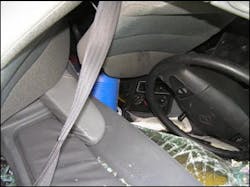'Crash Course' Quick Drill Series - Part XIX
This drill allows you to consider the what resources you have in your inventory and what actions you would decide to take to address the problems that you may have encountered.
When a car rolls over, it can complicate everything that has to be done at a crash scene. Stabilization, hazard control, electrical system shutdown, and especially patient care all take on a new dimension when the vehicle is upside down. When the vehicle that winds up on its roof is an 18-wheeler, things can get even more interesting.
Such was the case in McKinney, TX, when firefighters responded to a report of a vehicle rollover accident on a two-lane rural road. While enroute, crews were advised that the vehicle was a truck loaded with lumber and that it had rolled over into a ditch.
Fortunately for the truck's driver, although his accident was surely a frightening ride, he was able to escape from the cab of the vehicle prior to responders arriving on scene.
The damage to the truck and the position of the vehicle allow us to play the 'what if' game. By viewing the vehicle exactly as it was found when McKinney responders arrived, rescue personnel can "preplan" this crash and calculate what actions you and your team could have or would taken if the truck had rolled over in your district and the driver remained trapped.
As you review the crash scene, think about what resources you have in your inventory and what actions you would decide to take to address the problems that you may have encountered.
Here's a basic tactical checklist to get you thinking:
- Vehicle (and cargo) stabilization
- Hazard control: fluids, electrical, etc
- Initial patient access: window, windshield, door, body of vehicle
- Patient interior entrapment challenges: steering wheel, seat, floor, console/instrument panel, etc
- Possible jacking/lifting and shoring evolution
- Extrication pathway; door, body of vehicle
Using these rollover images, it is possible for you to think about what you would have done, look at your resources and areas where you may be short of tools to accomplish the task, and to review your rescue team's capabilities. Maybe at your next extrication training session, you can train on a skill that you've become rusty at. Maybe you have never considered something that now you see that you would have to do with a truck rollover rescue. This incident did not happen in your district but it can in the future and that's the value of this case study. Will you be ready when it does?
Crash Course Teaching Point: Study the images of an incident in someone else's district can be a valuable tool in 'preplanning' for a similar crash if it were to occur in your district.
Be Informed...Be Ready....Beware!
RON MOORE, a Firehouse.com Contributing Editor, is a battalion chief/fire training officer for the McKinney, TX, Fire Department. He is the author of the University of Extrication series, featured each month in Firehouse Magazine and is the moderator of the University of Extrication interactive forums on Firehouse.com. In 1984, he received the International Society of Fire Service Instructors George D. Post Instructor of the Year award for development of the first school bus rescue training program in the United States. In 2000, Ron was awarded the International Association of Fire Chief's "Excellence in Rescue" award. You can reach Ron by e-mail at [email protected].
